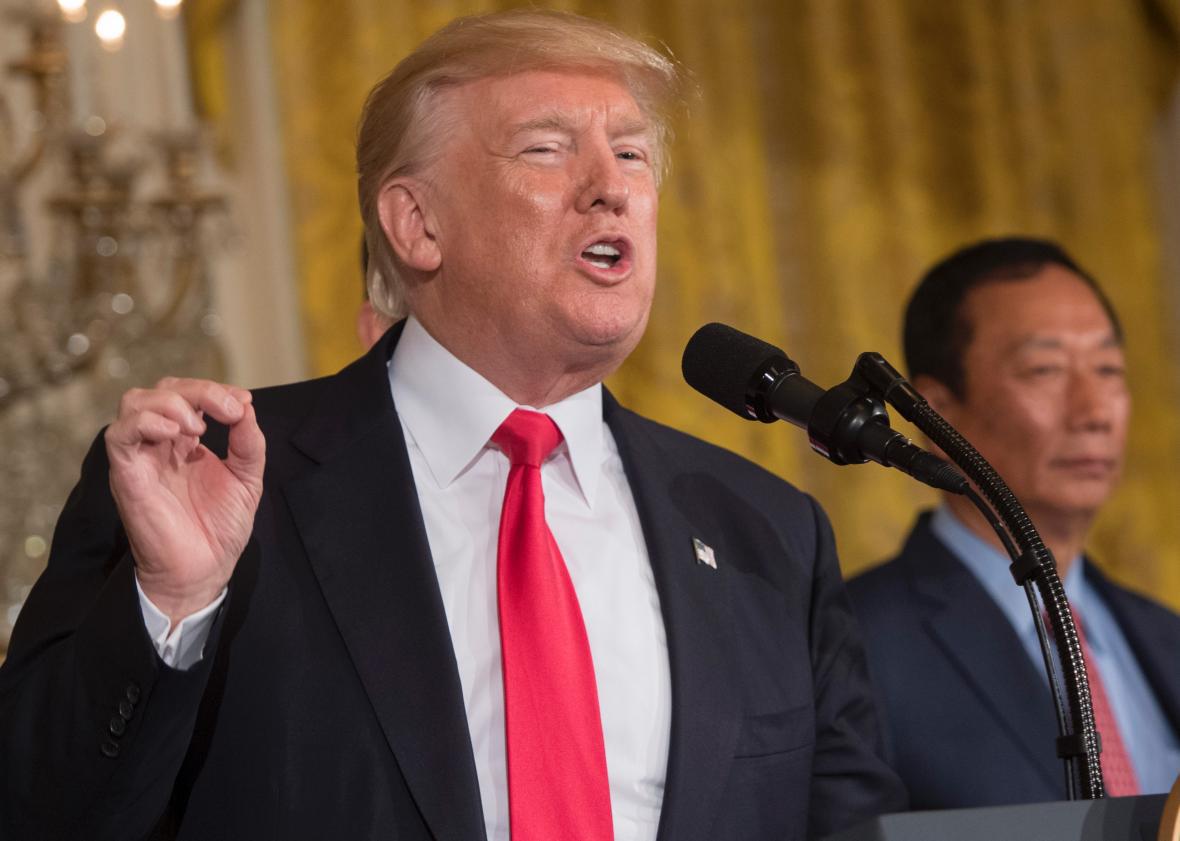On Wednesday, Foxconn— the Taiwanese manufacturing juggernaut that’s responsible for assembling Apple’s iPhone—announced that it plans to open a new plant in Wisconsin. If all goes to plan, Foxconn says it will create up to 3,000 new jobs initially, not including the labor that will go into building the plant. The company claims that eventually as many as 13,000 people could be employed.
But that’s a big if.
Any number of things could go wrong before shovels break ground: Foxconn could pull out, or it could decide to significantly reduce the size of the plant. Even if the factory is built, it’s probably going to filled with robots, which could mean far fewer than the promised 3,000 jobs.
Of course, none of that stopped Trump from crowing about it on Wednesday at a White House event, while Wisconsinites (and Republicans) Gov. Scott Walker and Rep. Paul Ryan stood by his side. Earlier in the week Trump proclaimed that “three big, beautiful plants” are on the way from Apple.
The new plant, which will make LCD screens, is slated to amount to a $10 billion investment from Foxconn, and each job is supposedly going to clock in an average salary of $54,000. Wisconsin sweetened the deal for the Taiwanese company by offering $3 billion in subsidies to offset the costs of coming to America. The simple math may make that sound like a good deal—$3 billion for $10 billion.
But as Tim Cuplan at Bloomberg points out, $3 billion for 3,000 jobs means the state is paying $1 million per job. But let’s be generous and factor in the construction jobs that would go into building the plant, which the state estimates could total 16,000 jobs, and the long-term estimate of employing 13,000 people at the plant. Those 29,000 jobs would still cost more than $100,000 a person in state subsidies.
But there’s an even bigger problem than recouping the state’s investment. Foxconn’s history and the future of manufacturing in general both suggest Wisconsinites shouldn’t bust out the six-pack just yet.
For one, Foxconn has a track record of promising factories to cities in need of jobs and not coming through. It happened in 2013 in Harrisburg, Pennsylvania, when Foxconn promised a $30 million factory that would employ 500 workers. The announcement made headlines, adding to both Foxconn’s and the Pennsylvania politicians’ political capital, but it was never actually built, and there’s no sign it will ever happen. Very little was made of the deal’s quiet death. It also happened in Vietnam in 2007 and Indonesia in 2014.
Even if a plant gets built, it could fall short of expectations. In 2011, Foxconn promised a plant in Brazil that was projected to create 1000,000 jobs. In 2015, the factory reported it employed roughly 3,000 people, and the company never explained why it fell short of its projections, according to Reuters.
Last year, Foxconn boasted that it replaced 60,000 workers with robots at a single factory in China. The company even makes its own industrial robots, dubbed Foxbots, that work on its assembly lines. Foxconn was making about 10,000 Foxbots a year in 2015.
Factories are increasingly coming to the U.S. in part because wages in China have been on the rise for the past 15 years—but also because the cost of robots is going down. It ultimately may prove cheaper to manufacturer products closer to the major markets where they sell.
Foxconn isn’t the only company that’s made efforts to manufacture in the U.S. in recent years. Look at the Carrier plant Trump claimed he helped convince to stay in the country last year. Carrier’s decision was driven in part by a plan to save on labor by adding more automation to the plant. Adidas also shared plans last September to open a new factory in Georgia that will be highly roboticized, only employing about 160 human workers.
Even if Foxconn lives up to its promises, the introduction of automated factories may ultimately lead to fewer human workers in the long run. Annual shipments of manufacturing robots to the U.S. are projected to rise 300 percent in the next nine years, according to the research firm ABI.
Those robots are going to have to work somewhere, and they’ll most likely find a home at whatever new factories come to the country, even the new ones that Trump claims to have had a hand in wooing to U.S. shores. Factories aren’t built to employ people. They’re built to make money. If it’s ultimately cheaper to buy a machine than pay a salary and medical benefits, robots are more likely to get the job. There’s no promise here that anything will improve for American workers beyond cheaper shipping costs for factory made goods. After all, it’s cheaper to ship an iPhone from California to Chicago than it is from Shanghai.
